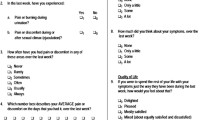Abstract
Chronic prostatitis/chronic pelvic pain syndrome (CP/CPPS) is a chronic pain syndrome identified by the presence of noninfectious pelvic or perineal pain lasting longer than 3 months. Current diagnoses and treatments for the syndrome solely depend on and target symptoms, respectively. Thus far, the mechanistic disturbances responsible for the pathogenesis of CP/CPPS have remained largely elusive and treatments, and therefore, continue to be ineffective. To move toward successful management and treatment of CP/CPPS, it is necessary to elicit the underlying biological mechanisms responsible for the syndrome. Therefore, a phenotyping system that is able to bridge the gap between current symptom-based diagnosis and future mechanistic approaches to diagnosis and treatment is needed. In this article, we examine current CP/CPPS phenotyping systems, analyze their utility, and make suggestions for changes in clinical approaches to the syndrome that would both promulgate a mechanistic understanding and advance treatment approaches.


Similar content being viewed by others
References
Papers of particular interest, published recently, have been highlighted as: • Of importance •• Of major importance
Collins M, Stafford R, O’Leary M, Barry M. How common is prostatitis? A national survey of physician visits. J Urol. 1998;159:1224–8.
McNaughton Collins M, Pontari MA, O’Leary MP, et al. Quality of life is impaired in men with chronic prostatitis: the Chronic Prostatitis Collaborative Research Network. J Gen Intern Med. 2001;16:656–62.
Rodríguez M, Afari N, Buchwald D. Evidence for overlap between urological and nonurological unexplained clinical conditions. J Urol. 2009;182:2123–31.
Litwin MS, McNaughton-Collins M, Fowler Jr FJ, et al. The National Institutes of Health chronic prostatitis symptom index: development and validation of a new outcome measure. Chronic Prostatitis Collaborative Research Network. J Urol. 1999;162:369–75.
Alexander RB, Propert KJ, Schaeffer AJ, et al. Ciprofloxacin or tamsulosin in men with chronic prostatitis/chronic pelvic pain syndrome: a randomized, double-blind trial. Ann Intern Med. 2004;141:581–9.
•• Dimitrakov J, Guthrie D. Genetics and phenotyping of urological chronic pelvic pain syndrome. J Urol 2009;181:1550–7. This article suggests the use of genome-wide association studies as a means of studying CPPS. It provides the evidence for a genetic component in CPPS etiology and offers a potential outline for characterization of CPPS phenotypes.
MAPP Research Network: A new look at urological chronic pelvic pain. Available at http://www.mappnetwork.org/. Accessed January 2011.
Semel Institute Consortium for Neuropsychiatric Phenomics: Whole Genome Association Analysis Strategies for Multiple Phenotypes. Available at http://www.phenomics.ucla.edu/index.asp. Accessed January 2011.
•• Nickel JC, Shoskes D. Phenotypic approach to the management of chronic prostatitis/chronic pelvic pain syndrome. Current Urol Reports 2009;10:307–12. This review argues the efficacy of UPOINT as a phenotypic approach to the management of CP/CPPS.
Bernal RM, Ponatri MA. Evaluation of chronic pelvic pain syndrome in men: is it prostatitis? Curr Urol Rep. 2009;10:295–301.
Alexander RB, Propert KJ, Schaeffer AJ, et al. Ciprofloxacin or tamsulosin in men with chronic prostatitis/chronic pelvic pain syndrome. Ann Intern Med. 2004;141:581–9.
Shoskes DA, Nickel JC, Dolinga R, Prots D. Clinical phenotyping of patients with chronic prostatitis/chronic pelvic pain syndrome and correlation with symptom severity. J Urol. 2009;73:538–42.
Magri V, Florian W, Gianpaolo P, et al. Use of UPOINT chronic prostatitis/chronic pelvic pain syndrome classification in European patient cohorts: sexual function domain improves correlations. J Urol. 2010;184:2339–45.
Shoskes DA, Nickel JC, Kattan MW. Phenotypically directed multimodal therapy for chronic prostatitis/chronic pelvic pain syndrome: a prospective study using UPOINT. J Urol. 2010;75:1249–53.
Anderson RU, Orenberg EK, Morey A, Chavez N, Chan CA. Stress induced hypothalamus-pituitary-adrenal axis responses and disturbances in psychological profiles in men with chronic prostatitis/chronic pelvic pain syndrome. J Urol. 2009;182:2319–24.
Lutgendorf SK, Kreder KJ, Rothrock NE, et al. Diurnal cortisol variations and symptoms in patients with interstitial cystitis. J Urol. 2002;167:1338–43.
•• McEwen BS, Kalia M. The role of corticosteroids and stress in chronic pain conditions. Metabolism 2010;59:S9–15. This paper establishes the complicated relationship between allostatic load and chronic pain conditions and suggests that a more complete understanding of this relationship in chronic pain conditions will improve clinical management of patients with such conditions, including CP/CPPS.
•• Juster RP, McEwen BS, Lupien SJ. Allostatic load biomarkers of chronic stress and Impact on health and cognition. Neurosci Biobehav Rev 2010;35:2–16. The authors establish groups of biomarkers that correlate with different allostatic load domains. The paper discusses the importance of data that may not meet clinical significance. Analysis of these data may provide insight into the mechanism of CP/CPPS.
•• Allsop SA, Erstad DJ, Brook K, Bhai SF, Cohen JM, Dimitrakoff JD. The DABBEC phenotyping system: Towards a mechanistic understanding of CP/CPPS. Nat Rev Urol 2011;8:107–13. This review introduces a new phenotyping system for CP/CPPS. The system addresses the mechanistic underpinnings of CP/CPPS and provides a framework for future research to improve mechanistic understanding of CP/CPPS.
White PC. Medscape: neonatal screening for congenital adrenal hyperplasia. Nat Rev Endocrinol. 2009;5:490–8.
• Dimitrakov J. A road map to biomarker discovery and validation in urological chronic pelvic pain syndrome. J Urol 2008;179:1660–1. This concept paper reviews the processes leading to biomarker discovery and examines the utility of different biomarkers in characterizing CP/CPPS.
Hewit SM, Dear J, Star RA. Discovery of protein biomarkers for renal diseases. J Am Soc Nephrol. 2004;15:1677.
• Schadt EE, Friend SH, Shywitz DA. A network view of disease and compound screening. Nat Rev Drug Discov 2009;8:286–95. This review examines how large-scale generation and integration of genomic, proteomic, and metabolomic data is increasingly allowing the construction of complex networks that provide the basis for understanding of the biological mechanisms that underlie disease states.
Disclosures
No potential conflicts of interest relevant to this article were reported.
Author information
Authors and Affiliations
Corresponding author
Additional information
Brandon Mahal and Jeffrey Cohen contributed equally to this work.
Rights and permissions
About this article
Cite this article
Mahal, B.A., Cohen, J.M., Allsop, S.A. et al. The Role of Phenotyping in Chronic Prostatitis/Chronic Pelvic Pain Syndrome. Curr Urol Rep 12, 297–303 (2011). https://doi.org/10.1007/s11934-011-0196-y
Published:
Issue Date:
DOI: https://doi.org/10.1007/s11934-011-0196-y




